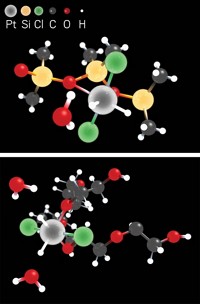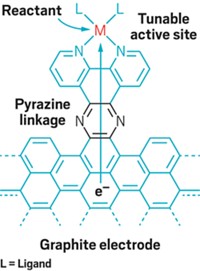Advertisement
Grab your lab coat. Let's get started
Welcome!
Welcome!
Create an account below to get 6 C&EN articles per month, receive newsletters and more - all free.
It seems this is your first time logging in online. Please enter the following information to continue.
As an ACS member you automatically get access to this site. All we need is few more details to create your reading experience.
Not you? Sign in with a different account.
Not you? Sign in with a different account.
ERROR 1
ERROR 1
ERROR 2
ERROR 2
ERROR 2
ERROR 2
ERROR 2
Password and Confirm password must match.
If you have an ACS member number, please enter it here so we can link this account to your membership. (optional)
ERROR 2
ACS values your privacy. By submitting your information, you are gaining access to C&EN and subscribing to our weekly newsletter. We use the information you provide to make your reading experience better, and we will never sell your data to third party members.
Synthesis
Molecular Mimic of Solid Catalyst
Metal-organics: Synthetic compound possesses key yet uncommon nanoparticle feature
by Mitch Jacoby
February 13, 2012
| A version of this story appeared in
Volume 90, Issue 7

New ways to synthesize catalytic materials for energy conversion and storage may be possible with a synthetic molecular complex that mimics the shape and reactivity of catalytically active sites in molybdenum disulfide nanoparticles.
MoS2 is well-known and thoroughly studied, because of its extensive use in the petroleum industry as a hydrodesulfurization (sulfur removal) catalyst. Several years ago, researchers in Denmark predicted and showed experimentally that MoS nanoparticles can also serve as effective catalysts for the hydrogen evolution reaction, a key step in light-driven hydrogen production from water.
Those results pointed to a low-cost alternative to the precious platinum group metals typically used for the hydrogen evolution reaction. Other studies have indicated that the nanocrystal bulk is mostly inactive and that the catalyst’s active sites are the relatively few triangular MoS2 units along the particle edges.
Now, a team from the University of California, Berkeley, which includes Hemamala I. Karunadasa, Christopher J. Chang, Jeffrey R. Long, and coworkers, has prepared a synthetic Mo(IV)-disulfide pentapyridyl complex that features the same type of uncommon triangular MoS2 units found along the nanocrystal edges (Science, DOI: 10.1126/science.1215868).
On the basis of electrochemical measurements and gas chromatographic analysis of acidic organic and aqueous solutions containing the complex, including a sample of unpurified California seawater, the team concludes that the new compound serves as an effective hydrogen evolution catalyst.
“These molecules, which possess the essential geometric and electronic structures of MoS2’s active sites, appear remarkably robust,” says University of Washington, Seattle, chemistry professor Daniel R. Gamelin. He adds that the compounds may open new routes to preparing highly active hydrogen evolution catalysts and provide insights into their inner workings.





Join the conversation
Contact the reporter
Submit a Letter to the Editor for publication
Engage with us on Twitter